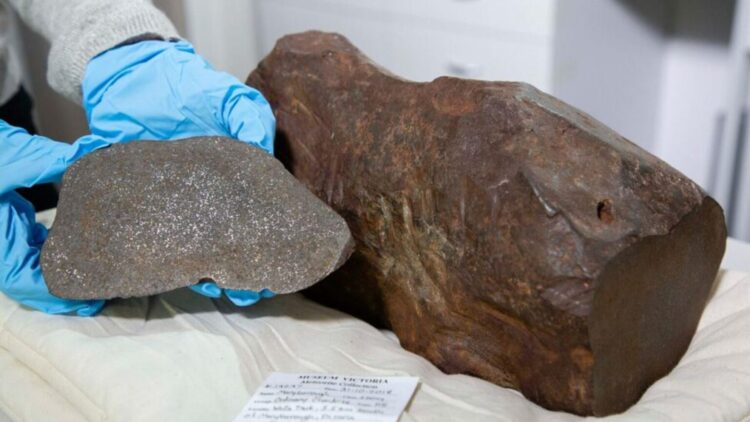In 2015, David Hole found, with his metal detector, a reddish and very heavy rock in Maryborough Regional Park (Australia) and decided to take it home, convinced that there was a gold nugget inside it. However, despite his attempts, he was unable to open the rock, as it was in fact a meteorite. Thanks to the Melbourne Museum this accidental find finally made David aware that his accidental find was a rare material, combining iron and nickel, but also gold. This meteorite, thanks to Australian science, has advanced the study of metallic meteorites and now the discoverer’s life has changed.
The Melbourne Museum was the key to the story.
Unable to open such a rock, he decided to take it to the Melbourne Museum to clarify what kind of rock he had found. “It had a sculpted, dimpled appearance,” Melbourne Museum geologist Dermot Henry told The Sydney Morning Herald media outlet in 2019. According to him, this type of rock forms once it passes through the atmosphere, which ‘sculpts’ it into this particular shape.
This rock weighs about 37.5 pounds (17 kilograms) and the scientists discovered that its composition was made up of a high percentage of iron, which implies that it was an ordinary H-type chondrite, the most common type of meteorite found on Earth. When they proceeded to open the meteorite, they discovered chondrules, round grains that are common in chondrites.
“It’s incredible, its rarity only makes its parts worth more to collectors,” one user said of the item. “It’s an awesome find, one of a kind really. Especially for those of us who spend it watching previous ones all night,” another person said about it.
Everything you need to know about the meteorite
The meteorite has been named Maryborough in honor of the location where it was found.
Weighing 17 kilograms and estimated to be about 4.6 billion years old, it serves as a time capsule containing materials older than the Earth itself. “Meteorites are scientific treasures because they are not just space rocks; they carry valuable information about the history of the solar system and the formation of planets,” said Dermot Henry, a geologist at the Melbourne Museum.
Composed mainly of iron, the Maryborough meteorite boasts a high percentage of this metal. When scientists examined its interior, they discovered chondrules—a rare feature that offers insights into the early stages of planetary formation. The meteorite’s characteristic surface, formed upon entering the Earth’s atmosphere, adds to its distinct features.
“Meteorites are the cheapest way to explore space”
“Meteorites are the cheapest way to explore space. They transport us into the past and give us clues about the age, formation and chemistry of our solar system,” said the geologist. These types of meteoroids contain, in some cases, ‘stardust’, which provides insight into how these were formed and how they evolved to create the various elements of the periodic table. “Other rare meteorites contain organic molecules such as amino acids, the building blocks of life.”
At the moment, the researchers do not know the provenance of the meteorite, although they suspect that it came from the asteroid belt between Mars and Jupiter. As for its dating, it is estimated that it has been on Earth for between 100 and 1,000 years, possibly arriving between 1889 and 1951, since there were several sightings at that time.
What is the price of meteorites
According to the aerolite.org site, meteorites are “valuable to both the scientific and collecting communities” and asking how much one would cost would be somewhat like you would do the same with “a car or a house.” “You will need to have specific information to arrive at an estimated value, which will be determined by different factors including rarity of type, size, condition, aesthetic appearance, among others,” the site details, stressing that they range in price from “a few dollars to hundreds of thousands.”
Other meteorites that also have a great story behind them
The Winchcombe meteorite, aptly named after the Gloucestershire town where it landed, is an extremely rare type called a carbonaceous chondrite. It is a stony meteorite, rich in water and organic matter, which has retained its chemistry since the formation of the solar system.

